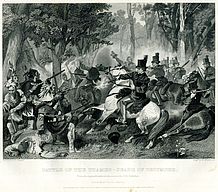Two-Way Collaborations in Spencer’s History
As visual images began competing with words for pre-eminence in historical texts, the collaborations between artists and historians were altered dramatically. Historians began deferring to the prior authority of the visual, and for the first time they wrote their texts with pictorial images in mind. Increasingly it was the visual around which readers established preconceived notions of historical worth, and it was the visual that increasingly conditioned interest in the literary. In the case of the History of the United States, it was the illustrations that dictated to the text, as it was Chappel who anticipated Spencer at almost every step of the process.
Occasionally Spencer worried that excessive visual packaging might obscure the literary intentions of his work. A subtle competition developed between them as to whose idealized visions would be given top billing. This rivalry had important financial implications for both author and artist, because each stood to benefit in terms of sales of collateral and future work if his name was associated first in the public mind with a successful History of the United States. These disagreements about the proper prioritizing of visual and narrative evidence in pictorial histories impacted the way publisher Johnson dealt with his employees on the project and cut to the heart of changing intellectual concerns about the direction of the genre.
Click on the overlapping areas of the Venn diagram to highlight specific relationships between publisher and historian, artist and publisher, and artist and historian.


